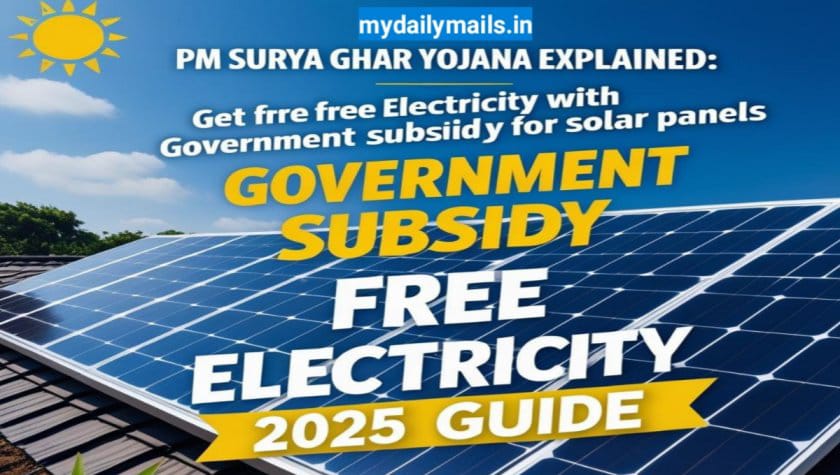
Want Free Electricity at Home? Go Solar with Subsidy!
If you’re planning to install solar panels at home and want the government to pay a portion of the cost, you’re in the right place. Under the PM Surya Ghar Muft Bijli Yojana, the Indian government provides direct subsidies to promote solar energy adoption in residential homes.
This article will explain why the government gives subsidies, who is eligible, how much subsidy is offered, and step-by-step instructions on how to apply online.
Why Does the Government Give Solar Subsidies?
The government provides solar subsidies to reduce the burden on coal-based power plants. Large thermal power stations burn coal to generate electricity. While electricity supplied to industries yields high revenue, households pay a lower tariff.
By encouraging homeowners to generate their own power through solar panels, the government redirects energy supply to industries—increasing revenue and reducing carbon emissions. Hence, to motivate citizens, the government offers financial support via solar subsidies.
Where Is Subsidy Applicable?
Solar subsidies are only available for residential properties. If you’re planning to install solar panels on an office, hospital, showroom, or factory, you won’t be eligible for subsidies.
| Location Type | Subsidy Eligibility |
| Residential Homes | Yes |
| Offices/Factories | No |
| Hospitals/Schools | No |
| Apartment Buildings | Conditional |
Types of Solar Projects & Their Subsidy Status
There are three types of solar projects you can install. Not all of them are eligible for subsidy.
| Project Type | Battery Backup | Grid Connection | Subsidy Available |
| Off-Grid | Yes | No | No |
| On-Grid | No | Yes | Yes |
| Hybrid (On Off Grid) | Yes | Yes | Yes |
Current Solar Subsidy Rates in 2025
Under the PM Surya Ghar: Muft Bijli Yojana, the following subsidies apply:
| System Size | Subsidy Amount (INR) |
| 1 kW | ₹30,000 |
| 2 kW | ₹60,000 |
| 3 kW or above | ₹78,000 (maximum) |
Note: Only homeowners with individual rooftops are eligible.
What About Apartment and Flat Owners?
For Low-Rise Buildings (3–4 floors):
If all flat owners agree, separate solar setups can be installed on the common rooftop. Each unit receives its own meter, inverter, and individual subsidy.
For High-Rise Buildings/Societies:
Housing societies can install common solar systems for shared utilities such as:
- Staircase lighting
- Lifts
- Water pumps
- EV charging stations
Government Subsidy: ₹18,000 per kW up to 500 kW
Example: 100 kW system = ₹18 lakh subsidy; 500 kW = ₹90 lakh subsidy
Special Subsidy for Hill & Island States
If you live in the following special category states/UTs, you get an additional 10% subsidy from the central government.
Eligible States:
- North-East: Assam, Arunachal Pradesh, Nagaland, Mizoram, Tripura, Meghalaya, Manipur, Sikkim
- Hilly States: Uttarakhand, Himachal Pradesh, J&K, Ladakh
- Islands: Andaman & Nicobar, Lakshadweep
Extra Subsidies from State Governments (Examples)
| State | Central Subsidy | State Subsidy | Total Benefit |
| Uttar Pradesh | ₹78,000 | ₹30,000 | ₹1,08,000 |
| Haryana | ₹78,000 | (Under Antyodaya Yojana for BPL families) | Varies |
| Other States | ₹78,000 | Depends on state | Varies |
Pro Tip: Your local solar vendor can tell you the latest state-level subsidies.
How to Apply for Solar Panel Subsidy (Step-by-Step Guide)
Step 1: Visit the Official Portal
Go to: https://pmsuryaghar.gov.in
Or the Step 2: Register as a Consumer
- Provide your mobile number, address, and electricity consumer number
or Step 3: Find a Solar Vendor
- Search vendors by state & city
- Check ratings, installation capacity, contact details
Know Step 4: Vendor Agreement
- Select vendor
- Upload signed agreement on the portal
Here, Step 5: Get DISCOM Approval
- DISCOM (your electricity board) reviews and approves the installation
And Step 6: Installation and Net Metering
- Solar setup installed
- Apply for net meter (also via portal)
- Inspection by DISCOM
- Net meter installation
Step 7: Commissioning Certificate
- Receive certificate from the portal
Step 8: Claim Subsidy
- Upload bank details and cancelled cheque
- Subsidy is directly transferred to your bank account
Example of a Trusted Solar Vendor
Easy Solar Solutions
- 25+ years of experience
- Works in India, Nepal, and the US
- Manufactures its own solar panels, batteries, and inverters
- Installed 300+ MW of solar capacity
- 750+ distributors across India
- Provides solar loans starting at 7% interest
- Brand ambassador: Boxer Vijender Singh
Having product + installation under one roof = better after-sales service and faster support.
Get Started Today: Go Solar, Save Big
With the PM Surya Ghar Yojana in place till FY 2026–27, now is the best time to install solar panels and reduce your electricity bills to zero. Whether you’re an individual homeowner or a housing society resident, you can benefit from massive subsidies and a cleaner energy future.
FAQs About PM Surya Ghar Yojana
Q1. Is this subsidy available for rented homes?
No, only for homeowners with rooftop rights.
Q2. Can I install solar panels in an apartment building?
Yes, if your society agrees and approves the setup.
Q3. Can I apply online myself?
Yes. Or you can authorize the vendor to apply on your behalf via the national portal.
Q4. What documents are needed?
- Electricity bill
- Proof of ownership
- Cancelled cheque
- Aadhaar card
Q5. Is any middleman involved in getting the subsidy?
No. The subsidy is credited directly to your bank account via the national portal.
External Resource:
Official Portal – https://pmsuryaghar.gov.in
If you’d like a live demonstration of the online application process, drop a comment below.





